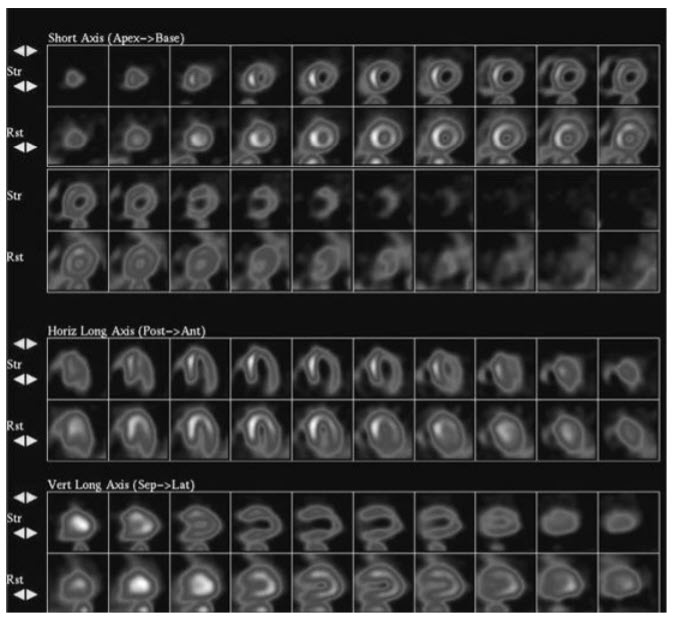Question 47#
The patient is a 75-year-old man with hypertension, diabetes, hypercholesterolemia, and coronary artery disease (CAD) who is 10 years s/p CABG: left internal mammary artery to LAD, saphenous vein graft (SVG) to RCA, and SVG to first obtuse marginal. He is asymptomatic on a good medical regimen, although he is relatively sedentary. TTE demonstrated normal LV systolic function with left ventricular ejection fraction (LVEF) 60%, moderately severe left ventricular hypertrophy (LVH), and no significant valvular disease. The patient is now sent for cardiac evaluation prior to surgery on his dilated abdominal aorta (7.5 cm in diameter). An adenosine nuclear stress test is ordered for preoperative risk assessment. During the adenosine stress he remained asymptomatic although he developed 2-mm ST depressions in I, L, and V2–V6 . There were no significant changes in blood pressure. Figure below shows the scan.

The scan demonstrates:
A. Marked attenuationB. Multivessel ischemia
C. Infarct but no ischemia
D. Mixture of infarct and ischemia
E. Motion artifact
Correct Answer is B
Comment:
Multivessel ischemia. The resting scan showed GI activity, but overall normal tracer uptake. There was increased septal uptake caused by the moderately severe LVH. Post stress there is severely reduced tracer uptake involving the mid- and apical anterior, entire anteroseptal, and inferolateral walls and inferior wall and apex. There was also cavity dilation post stress. This is known as transient ischemic dilation (TID). The gated images that accompanied this study demonstrated hypokinesis of the above segments. Note that the post-stress gated images are acquired post stress, but at rest. That is to say that there is a delay between stress and imaging, which may allow for some recovery of function. This scan is of high risk in that there is ischemia in all three vascular territories with TID and extensive wall motion abnormalities. Although the patient was asymptomatic under his baseline conditions, it was appropriate to order the adenosine nuclear stress test since the patient is diabetic with prior revascularization and with a questionable functional status who was going to undergo a high-risk surgical procedure (aortic aneurysm repair).